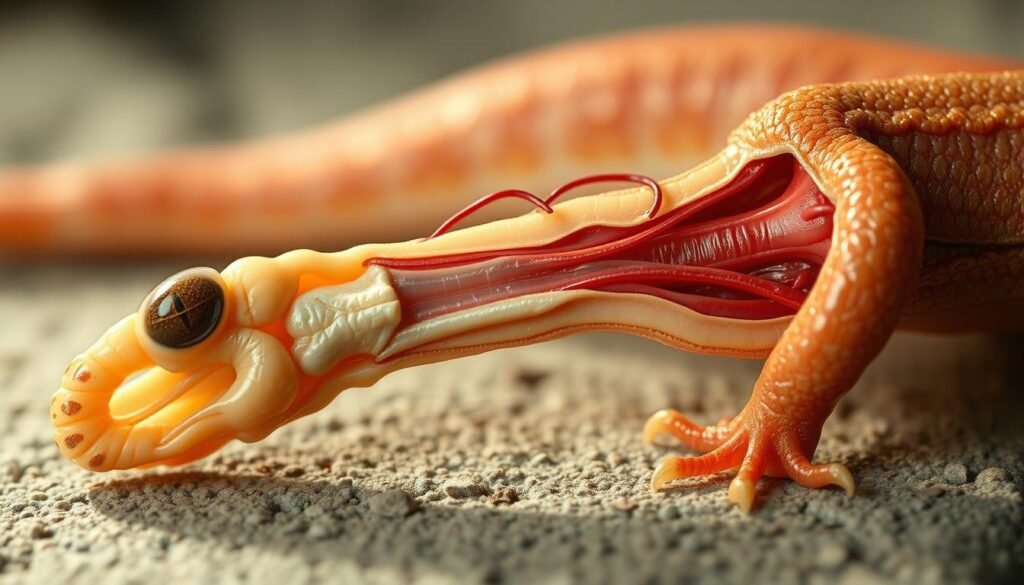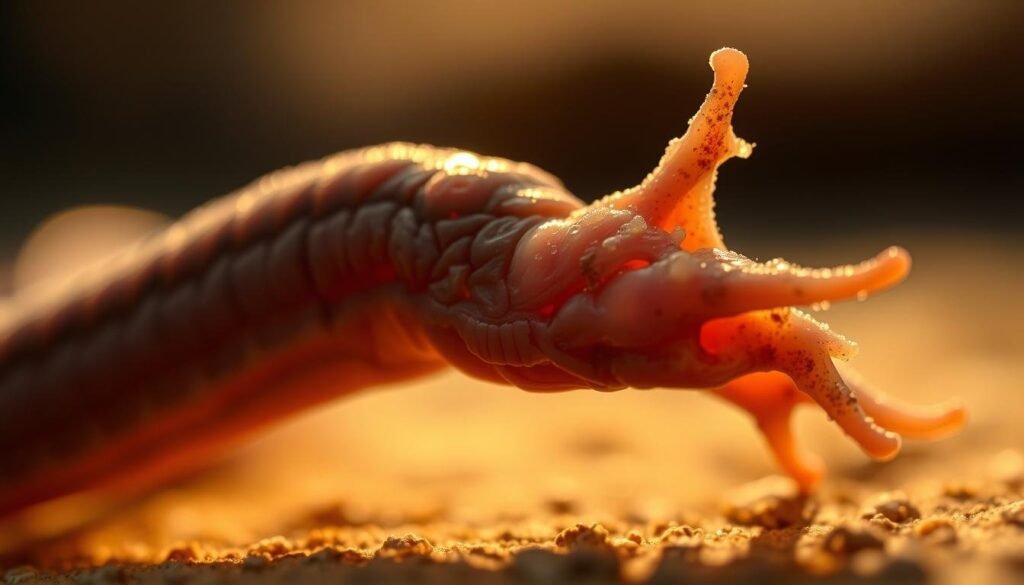Why Salamanders Regenerate Limbs So Effectively? Have you ever wondered how salamanders can grow back their limbs so easily? This amazing skill has caught the eye of scientists and the public alike. The way salamander regeneration works is not only fascinating but also very important for human health.
The ability to regrow limbs is a complex process that many are interested in. By studying limb regeneration, we can learn more about how to help humans with injuries and diseases.
Let’s dive into the world of salamander regeneration. We’ll look at the biological steps that make it happen. We’ll also talk about why this skill is crucial for salamanders’ survival.
Contents
- 1 The Remarkable Regenerative Powers of Salamanders
- 2 The Biological Mechanisms Behind Limb Regeneration
- 3 Why Do Salamanders Regenerate Lost Limbs Effectively?
- 4 Salamander Regeneration Compared to Other Animals
- 5 Salamander-Inspired Research in Human Medicine
- 6 Salamander Regeneration: Unlocking the Secrets of Limb Regeneration
- 7 FAQ: Why Salamanders Regenerate Limbs So Effectively?
- 7.1 What makes salamanders able to regenerate their limbs?
- 7.2 Which type of salamander is known for its exceptional regenerative abilities?
- 7.3 How do salamanders benefit from regenerating lost limbs?
- 7.4 What is the initial step in the limb regeneration process in salamanders?
- 7.5 How does salamander regeneration compare to other animals?
- 7.6 What is the significance of salamander-inspired research in human medicine?
- 7.7 What are some potential applications of salamander-inspired research?
- 7.8 Are there any key research institutions working on salamander regeneration?
The Remarkable Regenerative Powers of Salamanders
Salamanders can regrow their limbs with amazing precision. This shows their incredible regenerative powers. They can even regrow lost eyes and parts of their brain.
Axolotls are the top regeneration champions among salamanders. They keep their larval features as adults, a rare trait called neoteny. Axolotls can regrow their limbs, eyes, and parts of their brain, making them very interesting to scientists.
Axolotls: The Regeneration Champions
Axolotls can regrow their limbs, spinal cord, brain parts, and even fix damaged hearts. Their ability to heal makes them key for studying how to fix damaged tissues in humans.
Newts and Other Salamander Varieties
Newts also have impressive regenerative powers, though not as much as axolotls. They can regrow their limbs, eyes, and brain parts. Studying different salamanders helps scientists learn more about how regeneration works.
The regenerative powers of salamanders, like axolotls and newts, could lead to new human treatments. By studying how they regrow body parts, researchers aim to find ways to heal human injuries and diseases.
The Biological Mechanisms Behind Limb Regeneration
Exploring how salamanders regrow their limbs is complex. It involves many steps, each important for successful limb regeneration.
Initial Wound Healing Response
When a salamander loses a limb, the first step is wound healing. Skin cells quickly cover the wound. This step is key to prevent infection and start the regeneration process.
Blastema Formation and Growth
After healing, a group of cells called the blastema forms. This mass is vital for growing a new limb. It includes cells for muscle, bone, and nerves. [Why Salamanders Regenerate Limbs So Effectively?]
Genes like Msx1 and Msx2 play big roles in limb growth. They help control cell growth, differentiation, and pattern. This ensures the new limb is formed correctly.
Regulatory Mechanisms
The control of limb regeneration is intricate. It involves many signaling pathways. These pathways make sure the new limb grows right.
| Stage | Description | Key Factors Involved |
|---|---|---|
| Initial Wound Healing | The wound is covered by skin cells to prevent infection. | Growth factors, immune response |
| Blastema Formation | A mass of undifferentiated cells forms at the wound site. | Cell proliferation genes, signaling pathways |
| Limb Patterning | The new limb is patterned correctly. | Regulatory genes, morphogens |
Studying these mechanisms helps us understand salamanders’ regrowth abilities. It could lead to new ideas in regenerative medicine. [Why Salamanders Regenerate Limbs So Effectively?]
Why Do Salamanders Regenerate Lost Limbs Effectively?
Regrowing lost limbs is key for salamanders to survive in tough places. This skill gives them a big survival advantage. It helps them deal with predators and harsh conditions where injuries are common.
Predator Evasion Benefits
Salamanders can grow back lost limbs, which is crucial for avoiding predators. Losing a limb makes them more likely to be caught. But by regrowing it, they can escape and defend themselves again.
The way salamanders regrow limbs is complex. It involves many cell types working together. This complex process helps them fully recover their limbs, boosting their chances of survival.
Survival Advantages in Harsh Environments
Limb regeneration also helps salamanders in tough environments. They often face physical dangers like rocky terrain. Being able to regrow limbs lets them heal from injuries and keep thriving.
| Survival Benefit | Description | Advantage |
|---|---|---|
| Predator Evasion | Regrowing lost limbs to escape predators | Enhanced survival |
| Environmental Adaptation | Regenerating limbs to adapt to harsh environments | Increased fitness |
| Resource Competition | Regaining limb functionality to compete for resources | Improved foraging and mating |
Learning why salamanders can regrow limbs helps us understand their evolution. This knowledge can also guide research in regenerative medicine and tissue engineering.
Salamander Regeneration Compared to Other Animals
Salamanders can regrow lost limbs, a unique ability among animals. This isn’t just simple healing. It’s a complex process that lets them rebuild entire limbs, including bones, muscles, and nerves.
Evolutionary Trade-offs
Regrowing limbs comes with costs for salamanders. The energy needed for this might take away from other important functions. This trade-off is key when comparing them to animals that can’t regrow limbs.
Genetic and Cellular Differences
Genes and cells are crucial for salamanders’ regenerative powers. They have special genes and mechanisms that help them rebuild tissues. Other animals lack these, limiting their ability to regrow.
Looking at how different species regrow, we see these differences clearly. Here’s a comparison:
| Species | Regenerative Ability | Key Features |
|---|---|---|
| Salamanders | High | Complex limb regeneration, genetic and cellular mechanisms |
| Mammals | Limited | Limited tissue regeneration, scar formation |
| Zebrafish | High | Fin and heart regeneration, genetic mechanisms |

Exploring these differences helps us understand how salamanders can regrow limbs so well. This knowledge could lead to new ways to help humans heal.
Salamander-Inspired Research in Human Medicine
Scientists are studying salamanders to find new ways to treat human injuries and diseases. Salamanders can regrow their limbs, inspiring research in regenerative medicine.
Researchers want to know how salamanders can regrow their limbs. They hope to use this knowledge to create new treatments for humans. [Why Salamanders Regenerate Limbs So Effectively?]
Key Research Institutions and Breakthroughs
Several research institutions have made big strides in understanding salamander regeneration. The University of California and Harvard University have led the way. They’ve found the genetic pathways behind salamander limb regeneration.
| Institution | Breakthrough | Significance |
|---|---|---|
| University of California | Identified key genes involved in limb regeneration | Potential applications in human regenerative medicine |
| Harvard University | Discovered cellular mechanisms behind tissue regrowth | Insights into human tissue repair and regeneration |
| Stanford University | Developed new techniques for studying salamander regeneration | Advancements in understanding regenerative processes |
Recent Discoveries and Their Significance
Recent studies have shown the potential of salamander research. Scientists have found genes important for limb regeneration in salamanders. This could lead to new treatments for human limb loss.
These discoveries are important because they give us new insights into regeneration. They could lead to new therapies for humans. As research keeps advancing, we’ll see more innovative treatments.
Salamander Regeneration: Unlocking the Secrets of Limb Regeneration
Salamanders have amazing powers to regrow lost limbs. This has caught the attention of scientists. They see great potential for helping humans. [Why Salamanders Regenerate Limbs So Effectively?]
Research into salamander regeneration is growing. It’s helping us understand how to fix human injuries and diseases. This study is leading to new ways to treat health problems.
Scientists are learning from salamanders to create new treatments. They aim to help people recover from serious injuries. The future of medicine is looking up, thanks to these creatures.
See Also: Why Do Foxes Bury Food Remains in Soil?
FAQ: Why Salamanders Regenerate Limbs So Effectively?
What makes salamanders able to regenerate their limbs?
Salamanders can regrow their limbs thanks to stem cells. They also have a complex system that helps them grow back lost tissues.
Which type of salamander is known for its exceptional regenerative abilities?
Axolotls (Ambystoma mexicanum) are famous for their amazing ability. They can regrow their limbs, eyes, and even parts of their brain.
How do salamanders benefit from regenerating lost limbs?
Losing and regrowing limbs helps salamanders a lot. It lets them avoid predators, find food, and live in tough places.
What is the initial step in the limb regeneration process in salamanders?
First, they heal the wound. Then, they form a special group of cells called the blastema. This is the start of growing back their limbs. [Why Salamanders Regenerate Limbs So Effectively?]
How does salamander regeneration compare to other animals?
Salamanders have special genes and cells that help them regrow. This is different from other animals, which have their own ways of healing.
What is the significance of salamander-inspired research in human medicine?
Studying how salamanders regrow their limbs helps human medicine. Scientists hope to use this knowledge to create new treatments for injuries and diseases.
What are some potential applications of salamander-inspired research?
New research shows how salamander secrets could help humans. It might lead to new ways to help our bodies heal and grow back tissues. [Why Salamanders Regenerate Limbs So Effectively?]
Are there any key research institutions working on salamander regeneration?
Yes, many research places are studying how salamanders regrow. They’re learning about the genes and cells involved, which could lead to new medical discoveries.

Zyair Larson, based in Denver, Colorado, has over 12 years of experience studying animal behavior. He has worked with the World Wildlife Fund (WWF) and National Geographic, researching wildlife and sharing insights on animal habits globally.

